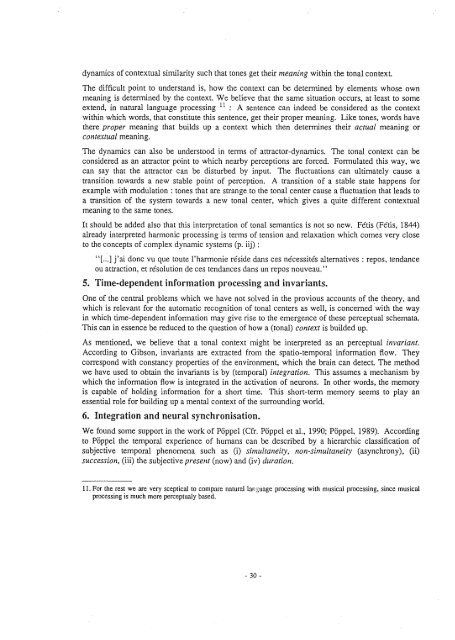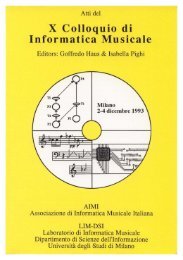Proceedings IX CIM 1991, Genova, November 13-16 - AIMI
Proceedings IX CIM 1991, Genova, November 13-16 - AIMI
Proceedings IX CIM 1991, Genova, November 13-16 - AIMI
You also want an ePaper? Increase the reach of your titles
YUMPU automatically turns print PDFs into web optimized ePapers that Google loves.
dynamics of contextual similarity such that tones get their meaning within the tonal context<br />
The difficult point to understand is, how the context can be determined by elements whose own<br />
meaning is determined by the context. We believe that the same situation occurs, at least to some<br />
extend, in natural language processing 11 : A sentence can indeed be considered as the context<br />
within which words, that constitute this sentence, get their proper meaning. Like tones, words have<br />
there proper meaning that builds up a context which then determines their actual meaning or<br />
contextual meaning.<br />
The dynamics can also be understood in terms of attractor-dynamics. The tonal context can be<br />
considered as an attractor point to which nearby perceptions are forced. Formulated this way, we<br />
can say that the attractor can be disturbed by input. The fluctuations can ultimately cause a<br />
transition towards a new stable point of perception. A transition of a stable state happens for<br />
example with modulation: tones that are strange to the tonal center cause a fluctuation that leads to<br />
a transition of the system towards a new tonal center, which gives a quite different contextual<br />
meaning to the same tones.<br />
It should be added also that this interpretation of tonal semantics is not so new. Fetis (Fetis, 1844)<br />
already interpreted harmonic processing is terms of tension and relaxation which comes very close<br />
to the concepts of complex dynamic systems (p. iij) :<br />
"[...] fai donc vu que toute l'harmonie reside dans ces necessites alternatives: repos, tendance<br />
ou attraction, et resolution de ces tendances dans un repos nouveau."<br />
5. Time-dependent information processing and invariants.<br />
One of the central problems which we have not solved in the provious accounts of the theory, and<br />
which is relevant for the automatic recognition of tonal centers as well, is concerned 'with the way<br />
in which time-dependent information may give rise to the emergence of these perceptual schemata.<br />
This can in essence be reduced to the question of how a (tonal) context is builded up.<br />
As mentioned, we believe that a tonal context might be interpreted as an perceptual invariant.<br />
According to Gibson, invariants are extracted from the spatio-temporal information flow. They<br />
correspond with constancy properties of the environment, which the brain can detect The method<br />
we have used to obtain the invariants is by (temporal) integration. This assumes a mechanism by<br />
which the information flow is integrated in the activation of neurons. In other words, the memory<br />
is capable of holding information for a short time. This short-term memory seems to play an<br />
essential role for building up a mental context of the surrounding world.<br />
6. Integration and neural synchronisation.<br />
We found some support in the work of Poppel (efr. Poppel et al., 1990; Poppe!, 1989). According<br />
to PoppeI the temporal experience of humans can be described by a hierarchic classification of<br />
subjective temporal phenomena such as (i) simultaneity, non-simultaneity (asynchrony), (ii)<br />
succession, (iii) the subjective present (now) and (iv) duration.<br />
11. For the rest we are very sceptical to compare natural language processing with musical processing, since musical<br />
processing is much more perceptualy based.<br />
- 30 -



